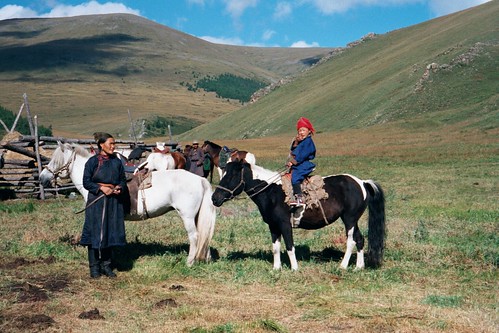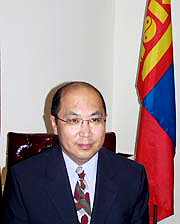Meeting With the Mongolian Ambassador
Seventy years of being run as a Soviet colony have left Mongolia resource-rich but people- and technology-poor. Half of the Mongol nation is, as they love to say in Beijing, “part of China.” Mongolia is squeezed between two great economic and diplomatic powers, one declining but still formidable, the other growing in power, arrogance, and appetite for resources. Nothing gets in or out of Mongolia without crossing the land or airspace of Russia or China.
Little wonder that Mongolia is trying to improve its ties to the United States. Mongolia offered a small contingent of troops to guard piplines in Iraq without even being asked. They’re still there, about to begin joint operations with South Korea’s Zaitun Unit, which seems poised to do something useful for once.
What struck me about Mongolians I saw in Korea was how physically similar they were to Koreans, far more than Japanese or most Chinese. The cultural similarities are also deep. Both the Koreans and the Mongolians are well aware of this. Koreans see Mongolians as ethnic kin, a living example of their ancestral past. Mongolians see Koreans as an example of what they could accomplish economically, as a bridge to their own prosperity. During the Korean War, Mongolia was firmly within the Soviet orbit and hosted North Korean war orphans.
The other thing that struck me was the pictures of Mongolia, mainly because of their stunning similarity to my own homeland in Western South Dakota (as Dan will confirm, it looks nothing like the flatter East-river half of the state). A thousand words for you:

More here. This could almost have been a scene from my home state a hundred years ago. One of the diplomats even said that a number of Mongolians had settled in Colorado for just that reason.
 Yesterday, I joined three other representatives of the North Korean Freedom Coalition in a meeting with the Mongolian Ambassador. Mongolia has recently become a transit point for North Korean refugees, which raised some initial talk of refugee camps, which in turn caused North Korea to send diplomats and reestablish relations. One cannot doubt that there was also considerable Chinese pressure. Today, Mongolia is firmly opposed to the establishment of refugee camps. At the same time, Mongolia’s opposition has some fiery advocates for North Korean refugees, and the government doesn’t want the matter to become a public issue (despite the ambassador’s conspicuous confidence that the Mongolian media won’t make it one . . . hmmmm).
Yesterday, I joined three other representatives of the North Korean Freedom Coalition in a meeting with the Mongolian Ambassador. Mongolia has recently become a transit point for North Korean refugees, which raised some initial talk of refugee camps, which in turn caused North Korea to send diplomats and reestablish relations. One cannot doubt that there was also considerable Chinese pressure. Today, Mongolia is firmly opposed to the establishment of refugee camps. At the same time, Mongolia’s opposition has some fiery advocates for North Korean refugees, and the government doesn’t want the matter to become a public issue (despite the ambassador’s conspicuous confidence that the Mongolian media won’t make it one . . . hmmmm).
Considerable and growing interest in the welfare of North Korean refugees within the U.S. Congress is the X Factor. Representative Joe Pitts is introducing a resolution praising Mongolia for a number of its policies, including its cooperation in the War on Terror and its willingness to look the other way while a few North Koreans escape through its territory. Mongolia obviously wants much closer relations with the United States, and Mongolia is aware that ill-treatment of refugees endangers that. Better treatment, on the other hand, could substantially raise Mongolian esteem in the eyes of Congress (and piss the Chinese off, since the refugees will be crossing their territory). The question is whether we’re willing to outbid the Chinese and North Koreans (think: free trade agreement!).
The issue may eventually become moot in the event that some North Korean diplomats get caught with a diplomatic pouch full of crystal meth at the Ulaan Bator airport. North Korean embassies have reportedly received instructions to provide their own financing. That usually means they get into the business of smuggling something.
Caveats: don’t take anything I say here as representing the Mongolian government’s positions. I’m interpolating much of what I say here, although I’ve tried to make sure that everything I’ve said is firmly grounded in the facts. I won’t get into everything that was discussed in the meeting, but it was interesting that this was the second such meeting between the Mongolians and the NKFC in as many months.
The take-away story was the Ambassador’s descriptions of negotiating with the North Koreans. He generally categorized the North Korean diplomats into three groups: low rank, mid-rank, and senior. Negotiating with the senior ones was generally fruitless. With the lower and mid-rank officials, it was sometimes possible. In all cases, the North Koreans were friendly when first meeting their counterparts, at least until they opened up their briefing books. From there, they would read aloud a litany of charges and stern accusations of collusion with capitalists, imperialists, and revisionists. When they were done, they’d close their books, engage in some serious hard bargaining, and it would end with the North Korean diplomats smiling and shaking hands, as polite as ever. Yet another example of the “doublethink” that Sharansky spoke of in his book.
The Ambassador described one meeting with the North Koreans, which he suggested had happened within the last year or two. During the talks, a Mongolian diplomat’s cell phone went off. He took the call. One of the lower-ranking North Korean diplomats started at him in fascination and asked, “what is that?” After the Mongolian diplomat told the North Korean that it was a telephone, the North Korean asked how it was possible for it to work without wires.
It’s hard to know just how isolated some North Koreans are–especially when it seems that cell phones are finding their way into North Korea–but the fact that until quite recently, at least one junior diplomat still hadn’t ever seen a cell phone certainly tells us much.
1 Response